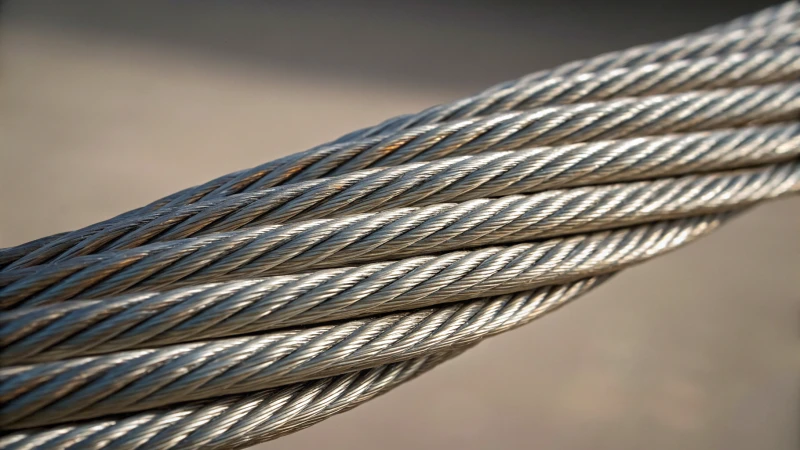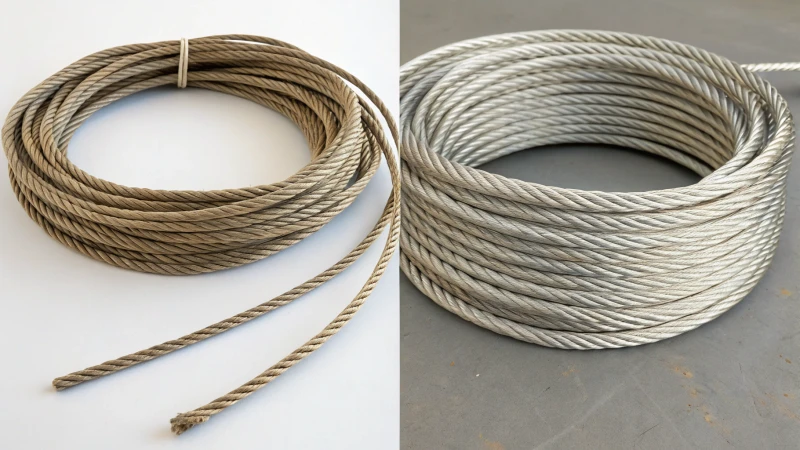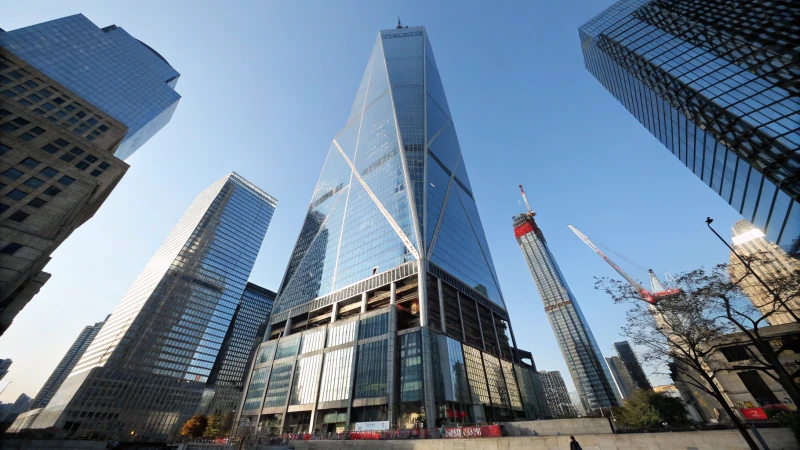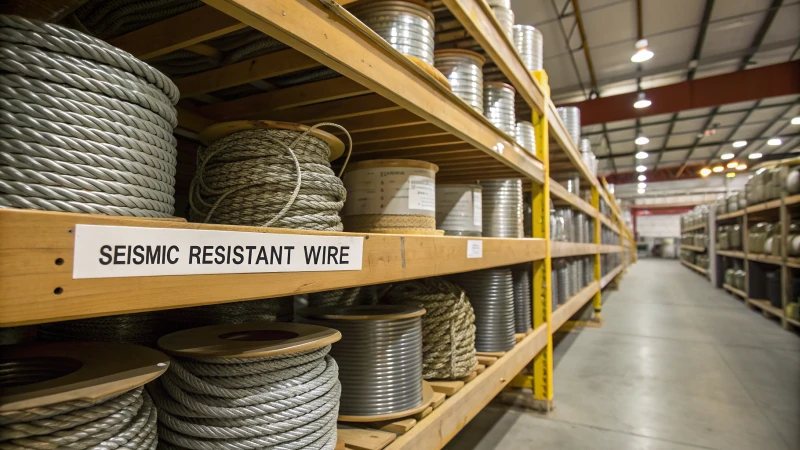
Imagine standing in a bustling city, knowing the very cables holding skyscrapers steady could mean life or death during an earthquake.
Wire rope construction impacts seismic performance by absorbing and distributing dynamic forces. Configurations like 7×19 and 6×36 offer enhanced shock absorption, crucial for seismic safety.
I remember when I first walked through a construction site in a seismic zone. The engineers passionately discussed wire rope configurations, knowing these choices could save lives. They explained how ropes like the 7×19 or 6×36 were crafted to endure the ground's violent shakes, absorbing energy and preventing catastrophic failures. But it's not just about the type of rope. Additional treatments, like anti-vibration coatings, play a pivotal role in enhancing durability and performance. These insights showed me that every detail counts when it comes to designing for safety in earthquake-prone areas.
7×19 wire ropes offer better shock absorption than 6×36.False
Both 7×19 and 6×36 configurations are effective, but neither is superior.
Wire rope construction is crucial for seismic safety.True
Proper wire rope construction helps absorb and distribute seismic forces.
What are the Key Features of 7×19 and 6×36 Wire Ropes?
Remember the first time you realized just how many different types of wire ropes existed? I was there once, too, and it was overwhelming. Let's break down the key features of 7×19 and 6×36 wire ropes to make things clearer.
The 7×19 wire rope is famed for its flexibility, perfect for dynamic applications like running rigging and winch cables. In contrast, the 6×36 wire rope boasts greater load-bearing capacity and fatigue resistance, making it ideal for heavy lifting tasks.

Understanding Wire Rope Construction
I've spent countless hours navigating the intricacies of wire rope construction, and it's a fascinating world. Each number combination tells a unique story about how those tiny wires are woven together. The first number signifies the strands, while the second indicates the wires per strand. Here's a quick look:
| Construction | Strands | Wires per Strand |
|---|---|---|
| 7×19 | 7 | 19 |
| 6×36 | 6 | 36 |
These configurations influence not just the rope's flexibility and strength but also how suited they are for various tasks.
Flexibility vs. Load-Bearing Capacity
I remember the first time I handled a 7×19 construction1; it felt incredibly flexible in my hands, much like an old friend who bends with you through thick and thin. Its smaller wires and greater number of wires per strand make it perfect for jobs requiring frequent bending.
On the flip side, when I needed something that could handle static loads without breaking a sweat, the 6×36 ropes2 were my go-to. With thicker wires, they offer unmatched strength and load-bearing capabilities.
Fatigue Resistance and Durability
Choosing a wire rope isn't just about immediate needs; it's about longevity. I learned early on to consider fatigue resistance seriously. The 6×36 design stands out here; its increased number of wires boosts fatigue resistance, crucial for heavy lifting under high stress.
While the 7×19 ropes may not be as robust against fatigue, they shine in environments where flexibility and ease of handling are key.
Application Suitability
In my experience, 7×19 ropes are like those agile athletes you see darting around with ease—they're often used in running rigging, winch cables, and control cables because of their flexibility. On the other hand, when I think of serious lifting tasks—like cranes or hoisting operations—the 6×36 ropes are like the heavyweight champions in this arena.
For more insights into wire rope classifications and their specific uses, you might find our guide on wire rope types3 quite enlightening. It helped me immensely in picking the right rope for each project.
7×19 wire ropes are less flexible than 6×36 ropes.False
7×19 ropes are more flexible due to smaller wires and more per strand.
6×36 wire ropes are ideal for heavy lifting applications.True
6×36 ropes have thicker wires, enhancing strength and load capacity.
How Do Anti-Vibration Coatings Enhance Seismic Performance?
Ever wondered what keeps our buildings standing tall during an earthquake?
Anti-vibration coatings boost seismic performance by absorbing and dissipating vibrational energy, reducing stress on structures during earthquakes. These coatings significantly enhance building safety and durability.

Understanding Anti-Vibration Coatings
I remember the first time I really thought about how buildings withstand earthquakes. It was after watching a documentary about the devastating power of these natural events. That's when I learned about anti-vibration coatings. These are special materials applied to surfaces to dampen vibrations. Imagine them as the unsung heroes quietly absorbing the energy that could otherwise cause so much damage. They work by transforming vibrational energy into heat, which then dissipates harmlessly into the environment, thus reducing stress4 on critical components of a structure.
The Science Behind Vibrational Damping
In layman's terms, vibrational damping is like turning a wild dance party into a calm gathering. The kinetic energy from vibrations converts into heat, thanks to the viscoelastic materials in these coatings. These materials have both viscous and elastic qualities, allowing them to absorb vibrations like a sponge soaking up water.
| Material Type | Functionality |
|---|---|
| Viscoelastic | Energy absorption |
| Elastomeric | Flexibility enhancement |
| Polyurethane | Surface protection |
Application in Seismic Zones
In areas prone to seismic activity, every layer of protection counts. I once spoke with an engineer who explained how they coat steel wire ropes, beams, and columns to safeguard vital components such as joints and connectors. By absorbing shocks, these coatings minimize the risk of fatigue failure5, especially during aftershocks, which often sneak in when least expected.
Benefits Over Traditional Methods
While traditional methods like base isolators primarily control movement, anti-vibration coatings offer several perks: they're less intrusive and can be easily applied to existing structures without major overhauls. Plus, they don't add much weight and are low maintenance compared to mechanical systems.
In industries dependent on heavy machinery or lifting operations—think construction and mining—the integration of these coatings can drastically cut down on downtime and maintenance costs linked to equipment damage during earthquakes. Long-term benefits? Prolonged equipment life and boosted operational efficiency.
Want to dive deeper? Explore more about advanced coating technologies6 that are revolutionizing infrastructure protection against natural disasters.
Anti-vibration coatings convert kinetic energy to heat.True
These coatings use viscoelastic materials to transform vibrational energy into heat.
Traditional seismic methods are more intrusive than coatings.True
Coatings can be applied without major modifications, unlike base isolators.
Why is Flexibility Important in High-Seismic Areas?
Have you ever wondered why some buildings sway like a graceful dancer during earthquakes while others crumble?
Flexibility in high-seismic areas is crucial because it allows structures to sway and absorb seismic energy, minimizing damage and protecting occupants. Using flexible materials and design, buildings can better withstand the forces of an earthquake, reducing the risk of collapse.

Understanding Seismic Forces
I remember sitting in my living room, watching footage of a skyscraper in Tokyo swaying during an earthquake. Instead of toppling over, it moved like it was doing a slow dance, flexing and bending with the rhythm of the earth. This is what flexibility does—it absorbs and adapts to seismic forces7. Rigid structures, on the other hand, tend to crack under pressure. With earthquakes being unpredictable, having adaptable designs is not just smart; it's essential for safety.
Material Selection for Flexibility
Thinking back to my first construction project, I was amazed at how choosing the right materials could make or break a building's resilience. I learned that reinforced steel and composite materials are akin to the superheroes of construction. They have the strength to hold firm and the flexibility to bend without breaking. Steel wire ropes, in particular, are a fantastic example—they're like the bungee cords of the building world, stretching and contracting as needed.
| Material | Flexibility | Usage in Seismic Areas |
|---|---|---|
| Reinforced Steel | High | Skyscrapers, bridges |
| Composite Materials | Moderate | Residential buildings, schools |
| Steel Wire Ropes | High | Suspension systems, cable-stayed bridges |
Engineering Techniques
Back when I was knee-deep in blueprints trying to design a structure that could withstand an earthquake, I discovered base isolation. Imagine putting your building on a set of springs; that's base isolation8 for you! It lets the building move independently from ground motion. Then there are flexible joints—like shock absorbers for buildings—that prevent damage by soaking up shocks.
Case Studies in Seismic Design
I can't forget my visit to the Tokyo Skytree. Standing at its base and looking up at its towering height, I was fascinated by its central column design that allows it to sway during an earthquake. It's not just a marvel of engineering but a testament to how we've harnessed flexibility to protect lives and investments. This kind of innovation shows just how far we've come in making flexibility a key player in seismic safety strategies.
Understanding why flexibility is vital in high-seismic areas means designing structures that can not only stand tall but also move gracefully when the ground shakes. It's about protecting lives, properties, and ensuring that buildings do more than just stand—they endure.
Rigid structures are safer in earthquakes.False
Flexible structures are safer as they absorb and dissipate seismic energy.
Base isolation reduces earthquake damage.True
Base isolation allows buildings to move independently of ground motion, reducing stress.
What Standards Should Seismic-Resistant Wire Ropes Meet?
Ever wondered what makes wire ropes strong enough to withstand earthquakes?
Seismic-resistant wire ropes need to meet specific standards for tensile strength, fatigue resistance, and elasticity. They must adhere to industry norms such as ISO 2408 and ASTM A1023, which ensure their reliability in earthquake-prone areas.

Key Standards for Seismic-Resistant Wire Ropes
I remember the first time I was tasked with sourcing seismic-resistant wire ropes for a project. It was daunting, knowing that lives and livelihoods hinged on the choices I made. Wire ropes in seismic zones need to be more than just strong; they have to withstand dynamic forces that can occur during an earthquake. That's why they must adhere to standards like ISO 24089, which specifies the mechanical properties needed for resilience against seismic forces.
Another critical benchmark is the ASTM A1023 standard, which goes into detail about the construction and performance criteria necessary for these ropes. It’s like having a blueprint that ensures the ropes can endure cyclical loads, much like the constant barrage of waves against a cliff face. These standards are more than just guidelines—they’re lifelines.
| Standard | Description |
|---|---|
| ISO 2408 | Specifies general requirements for wire ropes used in lifting applications, ensuring strength and reliability. |
| ASTM A1023 | Outlines construction and testing procedures for wire ropes to ensure durability and safety. |
Importance of Anti-Vibration Coatings
I once had a conversation with a supplier who told me about anti-vibration coatings. These coatings are like the unsung heroes during an earthquake, absorbing vibrations and preventing stress from concentrating on any single point of the rope. This feature can significantly reduce the risk of rope failure10 when it really counts.
Construction and Material Considerations
Deciding on the right construction type and materials for seismic-resistant wire ropes feels like choosing the perfect outfit for a storm—each layer plays a crucial role. Multi-layer constructions like 7×19 or 6×36 offer flexibility, distributing loads more evenly and reducing the chance of sudden failures. And using high-quality materials, such as galvanized or stainless steel, protects against environmental corrosion, enhancing durability.
I always consult with suppliers who understand these specific requirements11 to ensure compliance with all relevant standards. It’s a collaborative effort that involves not just meeting specifications but understanding the nuances of each project.
Understanding these standards isn't just about compliance; it's about ensuring safety and reliability in every seismic application I manage. It's about being prepared for the unexpected, knowing that I've done everything possible to safeguard against disaster.
ISO 2408 ensures wire ropes' seismic resilience.True
ISO 2408 specifies requirements for strength and reliability.
Anti-vibration coatings reduce rope failure risk in earthquakes.True
These coatings absorb vibrations, reducing stress on ropes.
Conclusion
Wire rope construction, particularly configurations like 7×19 and 6×36, significantly affects seismic performance by enhancing shock absorption and durability, crucial for safety in earthquake-prone areas.
-
Discover how the smaller wires in 7×19 construction enhance its flexibility for dynamic applications. ↩
-
Learn about the robust load-bearing capabilities of the 6×36 wire rope construction. ↩
-
Explore various wire rope types to find the best match for your specific industrial needs. ↩
-
Discover how anti-vibration coatings convert vibrational energy into heat, thereby reducing structural stress. ↩
-
Learn about fatigue failure, a common issue in seismic regions that anti-vibration coatings help mitigate. ↩
-
Explore the latest advancements in coating technologies that enhance seismic protection for infrastructure. ↩
-
Explore how seismic forces impact building stability and why flexibility matters in construction. ↩
-
Discover how base isolation systems function to protect buildings from seismic activity. ↩
-
Explore ISO 2408 to understand its detailed requirements for wire ropes, ensuring compliance with international safety standards. ↩
-
Learn about how anti-vibration coatings can enhance wire rope performance during seismic events by reducing stress points. ↩
-
Discover the benefits of multi-layer construction in wire ropes for better load distribution and flexibility in seismic applications. ↩

